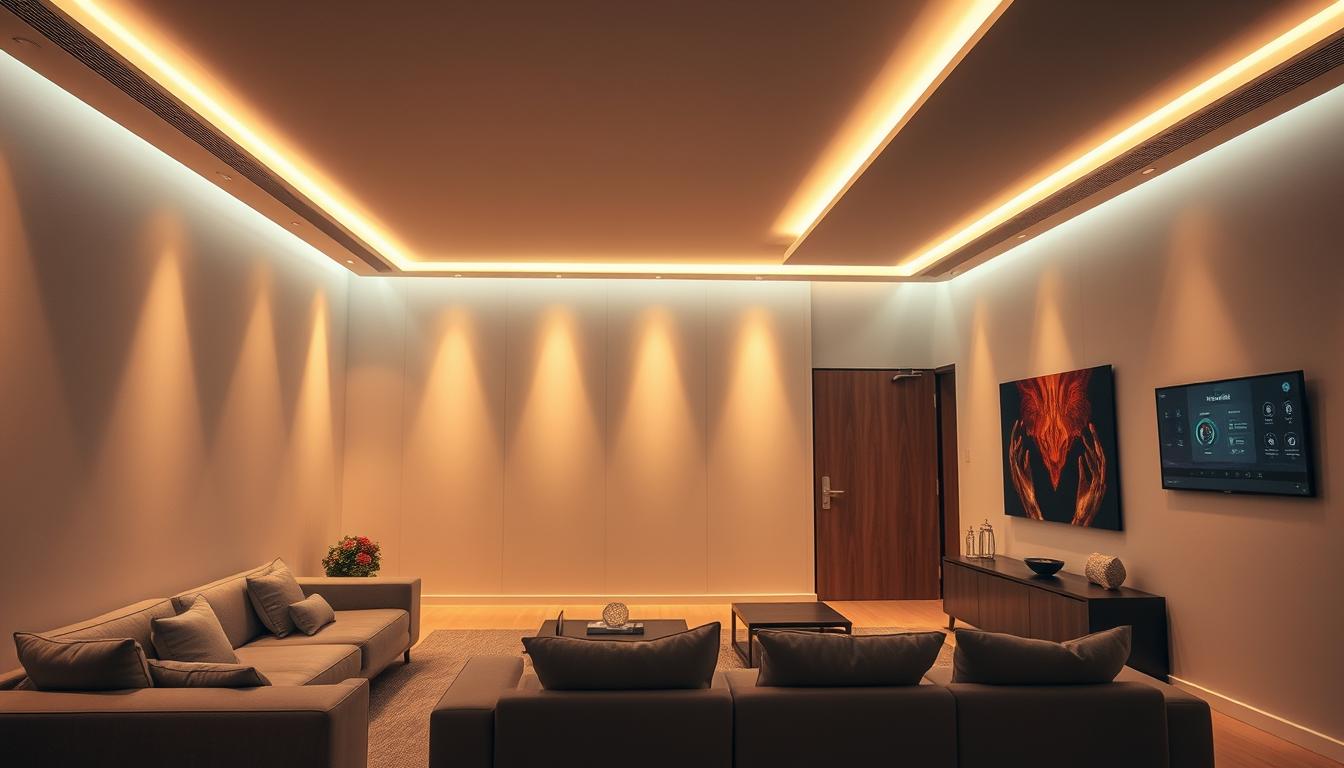I’ve found that automated lighting control makes my home more comfortable. It lets me change the lighting easily, whether I’m watching a movie or having guests over. This technology is a big part of smart lighting and home automation, helping me set the right mood for any time.
Automated lighting control has really changed my life. It’s part of my smart home setup, and I love it.
Exploring automated lighting control has shown me how easy and convenient it is. It’s a key part of my home automation systems. In this article, I’ll talk about its benefits and features. I’ll show how it makes my home better with smart lighting solutions.
What is Automated Lighting Control?
Automated lighting control uses technology to manage lights in homes or buildings. It lets users change light levels, set schedules, and scenes easily. This makes lighting personal and efficient.
Automated systems have sensors, controllers, and lights that work together. They offer a smooth and easy lighting experience. Intelligent controls help users set their lighting preferences and save energy. These systems can connect with other devices, making it simple to control lights from anywhere.
Understanding the Basics
To get how automated lighting works, learn the basics. These systems use hardware and software to control lights. They can create different scenes, from bright to soft.
Key Components of Automated Systems
The main parts of automated lighting systems are:
- Sensors: detect when someone is there, move, or the light level
- Controllers: send commands to lights based on sensor info
- Lighting fixtures: change light levels as told by controllers
Using automated lighting systems offers many benefits. It brings convenience, saves energy, and adds security. With smart controls, users can tailor their lighting to fit their needs perfectly.
Benefits of Automated Lighting Control
Automated lighting control brings many benefits to homeowners. It makes our homes more comfortable and energy-efficient. We can set lighting scenes to match our needs.
Some key advantages include:
- Convenience: Adjust lighting with ease, creating a comfortable atmosphere
- Energy Efficiency: Reduce energy consumption with scheduled lighting scenes and adjusted lighting levels
- Enhanced Security: Simulate occupancy and deter potential intruders with automated lighting
Wireless lighting control adds convenience. It lets us control our lights from anywhere. This is great when we’re away and want to keep our home safe.
By using automated lighting, our homes become more comfortable, energy-saving, and secure.
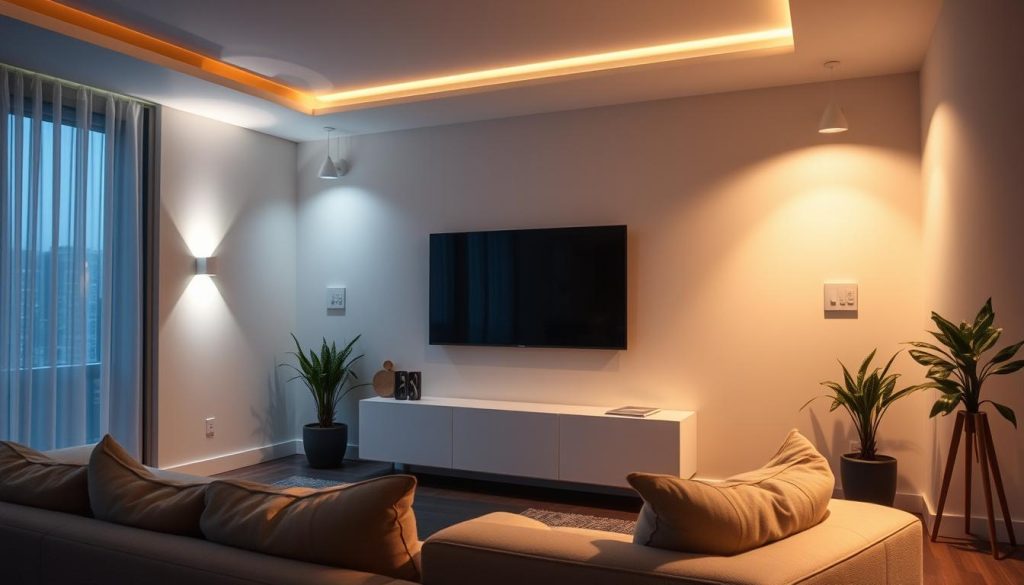
| Benefit | Description |
|---|---|
| Convenience | Adjust lighting with ease, creating a comfortable atmosphere |
| Energy Efficiency | Reduce energy consumption with scheduled lighting scenes and adjusted lighting levels |
| Enhanced Security | Simulate occupancy and deter potential intruders with automated lighting |
How It Works
Automated lighting control uses sensors and smart tech to adjust lighting based on the environment. It’s a key part of home automation systems. This lets users control lights from anywhere and enjoy features like scheduling and scene control.
Sensors detect things like when a room is empty or if it’s daylight. They then change the lighting to match. For example, lights turn off when no one is in the room to save energy. This works because automated lighting control talks to other devices in the home network.
Sensors and Smart Technology
Sensors are key in automated lighting control. They send real-time info about the environment. This info helps adjust the lighting to be just right.
Some common sensors include:
- Occupancy sensors
- Daylight sensors
- Motion sensors
Integration with Home Networks
Automated lighting control systems work with home networks. This lets users control lights with their phones or tablets. It also adds features like scheduling and scene control.
With automated lighting, users get smart lighting benefits. These include saving energy and improving security. It’s all part of a home automation system.
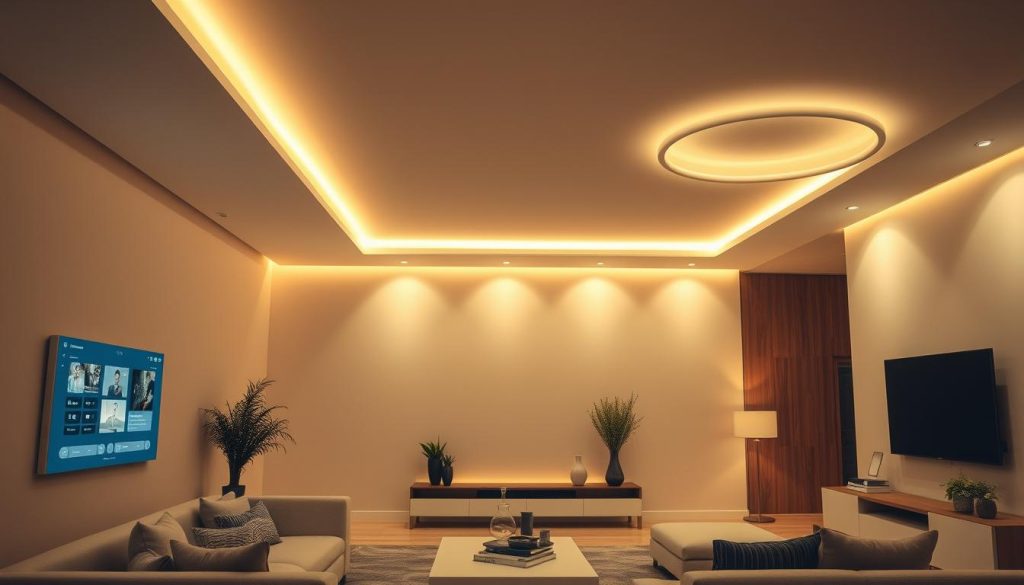
| Feature | Benefit |
|---|---|
| Energy Efficiency | Reduced energy consumption |
| Enhanced Security | Improved home security |
| Convenience | Easy control and customization |
Different Types of Automated Lighting
I’m excited to explore automated lighting options. Lighting control technology lets me set the mood with ease. It adjusts lighting levels, colors, and brightness, making life better and saving energy.
Automated lighting brings many benefits. It’s convenient, comfortable, saves energy, and boosts security. Here are some popular options:
- Smart Bulbs: These can be controlled wirelessly and adjusted to different colors and brightness levels, providing a high level of flexibility and customization.
- Dimmer Switches: These allow users to adjust lighting levels with ease, creating a personalized ambiance that suits their mood and preferences.
- Motion Detectors: These can detect occupancy and adjust lighting accordingly, providing an added layer of convenience and energy efficiency.
By using these automated lighting solutions, I can create a smart and efficient system. It meets my needs and improves my living experience. Automated lighting systems offer comfort, convenience, and sustainability.
There are many automated lighting solutions that offer great benefits. By choosing the right one, I can enjoy a better life. It’s more comfortable, convenient, and sustainable.
Setting Up My Automated Lighting System
Setting up an automated lighting system might seem hard, but it’s easier than you think. First, pick products that are easy to use, work well together, and save energy. Choosing energy-efficient lighting is key to saving money on your electricity bills.
When you’re ready to install, make sure you do it right. This ensures your system works well and saves energy. Wireless systems are great because they’re easy to set up and work with your current lights. They also connect with other smart devices in your home, making everything work better together.
Choosing the Right Products
- Think about what lighting you have and if it fits with the system you want
- Look for products that save energy, like LED bulbs and smart sensors
- Make sure the system can grow with you, so you can add more features later
Installation Tips
To make installation easy, follow the instructions from the manufacturer and stay safe. If you’re not sure, consider getting a professional electrician for help. By picking the right products and following these tips, you’ll enjoy a smart lighting system. This includes saving energy, controlling lights wirelessly, and integrating with other smart devices.
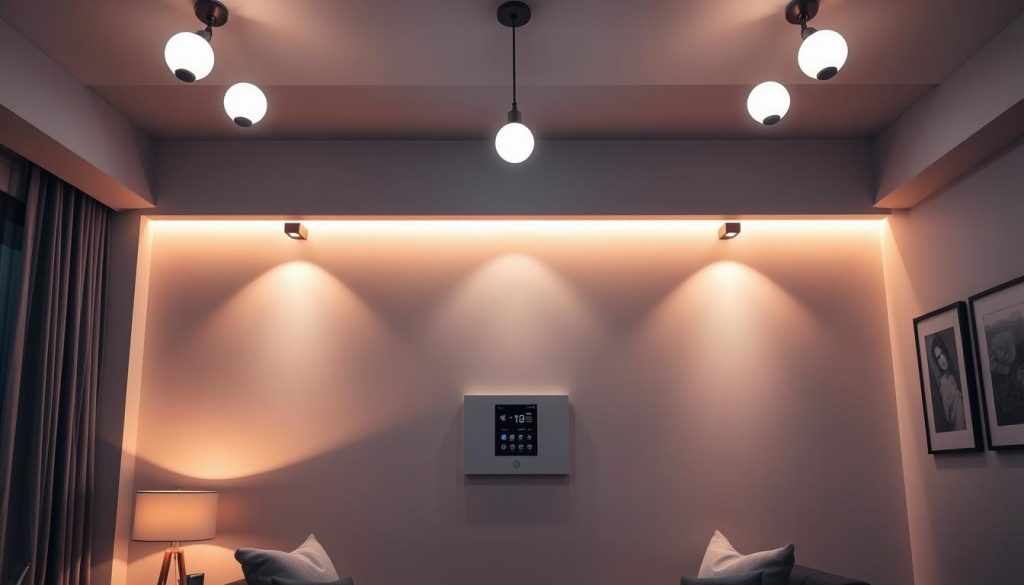
Customizing My Lighting Preferences
Automated lighting control lets me tailor my lighting to fit my needs. It makes my home feel more welcoming and cozy. I can change the brightness and color to match my mood, whether I’m unwinding, having guests, or working.
Automated lighting control also means I can set up different lighting scenes. This lets me adjust the lights in each room to create a unique feel. For instance, I can make my living room warm and inviting or my office bright and lively. I can control these scenes from anywhere, making it easy to change the mood of my home.
Creating Lighting Scenes
To set up lighting scenes, I use smart bulbs or dimmer switches. These can be controlled with a smartphone app or voice assistant. This makes it simple to change the lighting to match my preferences. I can also set these scenes to turn on and off at specific times, keeping my home lit and comfortable.
Scheduling and Timers
Scheduling and timers are key parts of automated lighting control. They let me automate my lighting scenes, ensuring they’re always just right. For example, I can set my living room lights to turn on at sunset or my bedroom lights to go off at bedtime. This saves energy and makes my home more convenient and comfortable.
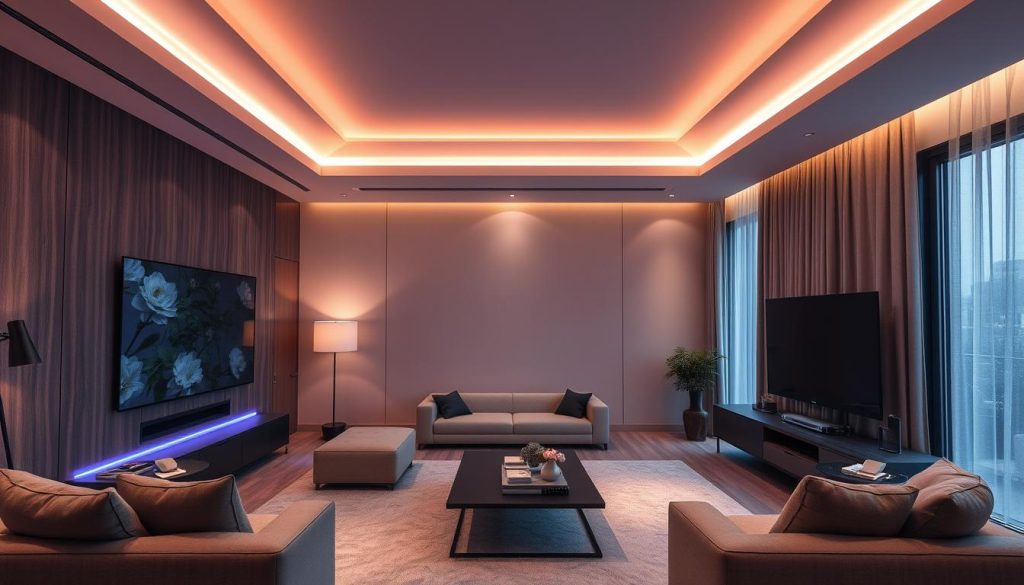
Remote Access Features
Remote access is another great feature of automated lighting control. It lets me control my lighting scenes from anywhere using my phone or tablet. This is super useful when I’m not at home and want to make sure it’s secure and welcoming. With automated lighting, I can relax knowing my home is always comfortable and safe.
Energy Savings with Automated Control
Exploring automated lighting control, I found it cuts down energy use and lowers bills. Adjusting lights and schedules helps avoid waste and saves energy. This is where energy-efficient lighting control shines, making lighting systems work better and reducing our environmental impact.
Automated lighting integration promotes green living. It encourages users to use less energy, leading to lower bills. For example, wireless systems can automatically switch off lights when not needed. This saves energy and extends light fixture life.
Automated lighting control cuts energy use in several ways:
- Automated scheduling: Lights turn on and off automatically, no need to touch them.
- Occupancy sensing: Lights go off when no one is in the room, saving energy.
- Dimming capabilities: Lights can be dimmed to use less energy when bright isn’t needed.
In summary, automated lighting control has many benefits. It saves energy and encourages eco-friendly habits. By using energy-efficient and automated lighting, we can help the planet and cut down on electricity costs.
| Feature | Benefit |
|---|---|
| Automated scheduling | Reduces energy waste by turning off lights when not in use |
| Occupancy sensing | Eliminates energy waste by turning off lights when a room is unoccupied |
| Dimming capabilities | Reduces energy consumption by dimming lights when full brightness is not required |
Enhancing Home Security with Automation
Exploring automated lighting control shows its big impact on home security. Smart lighting solutions help make our homes safer and more secure. By simulating occupancy, it looks like someone is home, even when no one is.
This can scare off potential intruders. It’s a powerful way to keep our homes safe.
Motion-activated lighting is a key feature of automated lighting control. It turns on when it senses movement. For example, if someone approaches my house when I’m away, the lights turn on.
This makes it seem like someone is inside. It’s a great addition to home automation systems, adding security and peace of mind.
Motion-Activated Lighting
Motion-activated lighting is simple yet effective for home security. It can be set up in various places like the front door or backyard. By installing these lights, I can make my home well-lit and secure.
It also works well with other home automation systems. This includes security cameras and door locks, creating a full security system.
Simulating Occupancy
Automated lighting control also helps by simulating occupancy. I can adjust lighting scenes and schedules to make it seem like someone is home. This is especially useful when I’m away for a long time.
With automated lighting, I can set up a schedule for lights to turn on and off. This makes it seem like someone is inside. It’s a great feature for anyone wanting to boost their home security with smart lighting.
Troubleshooting Common Issues
Automated lighting control systems can have problems. It’s key to know the basics of lighting control tech. When I face connectivity issues, I first check the device connections and settings.
Debugging light malfunctions can be tough. But, the right troubleshooting can solve problems fast. Common issues include faulty sensors, wrong wiring, or devices that don’t work together. I suggest using systems with easy-to-use interfaces and smart controls.
Here are some troubleshooting tips for common issues:
- Check device connections and configurations to ensure proper connectivity
- Verify that devices are compatible with the automated lighting system
- Use diagnostic tools to identify and resolve issues with lighting control technology
By using these tips and smart lighting controls, I can fix problems quickly. This lets me enjoy my automated lighting systems. With the right tech, I can make my living space comfortable and save energy.
| Issue | Cause | Solution |
|---|---|---|
| Connectivity problems | Incorrect device configuration | Check device connections and configurations |
| Light malfunctions | Faulty sensors or incorrect wiring | Use diagnostic tools to identify and resolve issues |
Future Trends in Automated Lighting Control
Exploring automated lighting control, I’m thrilled about the future trends. Smart home integration and AI are leading to endless possibilities. Wireless lighting control is becoming popular, letting users control lights with their phones or tablets.
Automated lighting integration is also on the rise. It connects lighting systems with other smart devices in the home. This creates a seamless smart home experience, making energy management easier. Benefits include:
- Enhanced energy efficiency through automated lighting schedules and scenes
- Increased convenience and comfort through voice control and remote access
- Improved home security through motion-activated lighting and simulated occupancy
AI advancements will bring new features to automated lighting systems. For instance, some systems can learn and adapt to your preferences. This leads to a more personalized and efficient lighting experience. Energy-efficient lighting control will help reduce energy use, making our homes and communities more sustainable.
The future of automated lighting control is bright and full of possibilities. With smart home integration and AI, we’ll see more innovative features soon. Whether upgrading or installing a new system, now is the time to explore automated lighting control. Enjoy the convenience, comfort, and energy efficiency it offers.
Why I Love My Automated Lighting Control System
I’m a big fan of home automation, and my automated lighting system has changed my life. It’s convenient, saves energy, and boosts security. I couldn’t go back to old lighting ways.
Personal Experience and Satisfaction
Installing my smart lighting was a game-changer. I love how I can control the lights with my phone. It makes cooking, cleaning, and hosting easier.
Creating custom lighting scenes has added elegance to my home. It feels like it’s made just for me.
Final Thoughts on Effortless Illumination
In the end, I’m really happy with my home automation system. It’s made my life better with its easy lighting control. If you want to improve your home, consider automated lighting.

